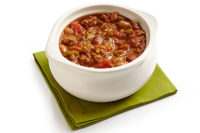Yes, the U.S. foodservice industry experienced a record $604 billion in sales in 2011, making it the best operating environment for the industry in the last four years. However, profit margins and commodity costs have made profitability at foodservice a constant struggle.
Yes, retail sales are strong, as consumers are eating at home more often. However, price inflation has forced some consumers to trade down in many cases, and private-label goods continue to eat into branded products’ sales.
In spite of the problems plaguing the industry, there remains room to grow in both the retail and foodservice segment — even if the growth is more modest than it has been in past years. The key to success in 2012, for both meat processors and their customers, is to provide value.
“While there are certainly customers who have had to cut back dramatically in all areas of their household budgets, we’ve seen evidence that people still shop the deli — but they’re more value-conscious,” says Alan Hiebert, education information specialist for the International Dairy-Deli-Bakery Association.
“Over the past few years, there have been a greater number of value-added products put into the supply chain,” adds Hudson Riehle, senior vice president of research for the National Restaurant Association. “In this environment, it really becomes an important component of success, because it allows the labor that would have been resident in that [restaurant] to be moved down the supply chain, where it can be done with greater efficiency and economics of scale.”
Value at the foodservice level
Profitability in the foodservice industry has been hampered by high inflation rates, says Erin Lash, senior equity analyst for Morningstar Inc. She notes that a recent estimate from Sysco Corp. put the food cost inflation level at 6 percent, compared to 2 percent last year.
“A modest level of food inflation — 2 to 3 percent — is ideal, but a rampant spike in food costs can pressure the firm and its customers, as it is now,” she says. The traditional method of handling higher inflation has been to raise costs to customers, but double-digit inflation in categories like meat and seafood make that pass-along more challenging.
However, there is a pent-up demand for restaurant dining, says Riehle. He says that consumer surveys held by the National Restaurant Association indicate that two out of five adults are not dining out as much as they would like. With nearly half of all the country’s food dollars going to the restaurant community, consumers have shown a desire to eat out when it’s financially possible to do so. However, with dining out becoming more of an occasional treat than a regular occurrence, there is increased competition to get those dollars.
“If the customer’s last experience in terms of food quality, service and price-value relationship doesn’t meet their expectations, they’re quick to vote with their feet,” he says. “It’s quite important for operators to give consumers, in essence, a nudge to make the decision to patronize.”
Part of that nudge, Riehle says, is to provide signature products, and meat is obviously a large part of a signature dining experience. Restaurants are also looking increasingly toward value-added products as a way to save money through operation efficiency and productivity gains. Riehle sees a greater emphasis on value-added products and increased cooperation between foodservice operators and their meat suppliers to produce products that can help eliminate much of the kitchen preparation.
Riehle noted that the upper-end, white-tablecloth restaurants have traditionally been the place where new ingredients, new dishes and new cuisines have been created, and it gradually filters down to the rest of the foodservice industry. That trend is continuing, but it is happening at an increasingly accelerated pace.
“If you look at many of the menu offerings in quick-service and fast-casual restaurants now, many of those items and preparation techniques were relatively recent in upscale service restaurants,” he says. Part of that development, he explains, is the increasing sophistication among consumers, particularly younger consumers. From a supplier standpoint, it means that companies that used to focus on a specific segment like fine dining should realize that the consumer’s knowledge of new products and expectation of having that product in different settings is growing.
Lash says that restaurants also should look to continually introduce innovative products at value prices — with an emphasis on “continually.”
“Wendy’s revenues received a boost from the introduction of new fries last year, but this was short-lived,” she says. “Customers are always looking for the next new thing.”
When it comes to restaurant segments, the fast-casual market has been one of the fastest-growing segments in foodservice, and Paul Damico, president of Moe’s Southwest Grill, says he expects that trend to continue.
“That segment is gobbling up consumers from the full-service segment and the fast-food segment,” he says. “We’ve got consumers continuing to trade down to fast-casual, and we’ve got consumers who, on a lot of occasions, want to trade up from fast food. We’re right in that sweet spot.”
Damico says that Moe’s sales will end up being about 3.5 percent ahead of 2010 when the company’s fiscal year is completed (ahead of the industry average of 2.5 percent), and he is anticipating growth of about 2.8 percent in 2012. Part of the company’s growth plans lie in new unit development.
“As we get into 2012, we expect to, at minimum, open one new restaurant per week,” he says. “We’re also seeing growth outside of our core market. Today we operate in 32 states domestically, and we plan to enter into five new states in 2012.”
Expanding into retail
One of Moe’s other recent growth strategies has been to expand into the retail market through licensed products. Moe’s parent company, Focus Brands, has a consumer goods licensing business that has helped Cinnabon develop many retail products. Damico says that he was approached about an opportunity to introduce Moe’s-branded products into BJ’s Wholesale Club. Through a very aggressive development plan, Moe’s introduced 14 new products, including salsa, bean dip, guacamole and chicken empanadas, into BJ’s refrigerated foods department.
“What typically takes 18 months to get a licensed product inside a club store or supermarket channel, we got accomplished in about six months,” Damico says, adding that the products have outperformed all expectations.
The Moe’s retail items are expanding into more than 800 stores nationwide, thanks to additional deals with Super Target, Price Chopper and other stores. The licensed products do not include products that Moe’s restaurants are known for, such as fajitas and burritos, as the goal of the project was to expand the company’s product line and not replicate it. It also assured the company’s 200-plus franchise partners that it was not looking to grow sales at retail at the expense of the foodservice sector.
Damico says that expanding into retail is a desire that most restaurant brands have.
“It is a very efficient way to grow revenue,” he explains. “In the BJ’s club store, we fit very comfortably in the refrigerated foods section with Panera and Legal Sea Foods and some other high-quality restaurant brands.
“The single biggest challenge,” Damico adds, “is making sure the products produced in the licensing arena meet our specifications. We are going to control what our products look and taste like, and if we can do that, we are confident that the product is being well-represented to the consumer.”
For that reason, Moe’s did not release any type of frozen Mexican entree, because that would not fit with the restaurant’s promise of fresh, handmade products.
Retail merchandising
While slower economic growth may lead to lower commodity costs going into 2012, Lash at Morningstar expects prices at retail to remain high for several months due to hedging contracts.
“In our view, brand strength will be tested over the next several quarters [to see] whether these higher prices can be sustained without a significant hit to volumes,” she explains, “especially if bigger price hikes are needed to cover costs.”
Lash notes that private-label manufacturers have taken market share over the past year, and she does not expect the consumer to trade up back to branded products anytime soon. Consumer product companies have the further disadvantage of having to spend on research and development, marketing, and advertising, while private-labelers do not.
Rising feed costs have led to sizable increases in sales, but Lash says it is difficult to predict where input costs will be in 2012.
“Commodity prices could be volatile, to say the least,” she says. “Futures have come off of highs, but they could easily go up again. If the rate of commodity inflation slows, it’s possible that some of the margin pressures that these meat-processing firms have faced could reverse.”
Hiebert notes that deli sales continue to rise, though the growth is slower than years past. Consumers are searching for value — though “value” means different things to different people — quality, price, food source, menu trends, and benefits or drawbacks of consumption can all play a part.
“Stores may need to deliver the value message in several ways,” he says. “The message of value can be conveyed through signage, packaging, verbal interaction, social media and merchandising, among others. I think stores and brands that do the best jobs of conveying value stand the best chances of success in the next year.”
One successful instance of using merchandising to increase sales has been Tyson Deli’s wing and tender merchandising. The company has found that using visible merchandisers for wings and tenders have helped those items go from tailgating/football-season favorite to year-round sellers.
Tyson’s research indicates that 25 percent of customers shop the deli area, but 43 percent shop mobile merchandisers in high-traffic areas. With the right wing and tender merchandising, retailers were able to increase sales by 40 percent, with nearly 60 percent of wing sales coming from impulse purchases.
The key strategies to ensure a successful “wing bar” were quality wings, in-store merchandising, bundling wings with beverages, and hiring dedicated staff who are trained and motivated to manage the wing bar.
“Our experience in working with retailers shows that, when Tyson insights are put into motion, deli operators may see astounding results,” says T FuQua, Tyson Deli brand manager. “In fact, participating retailers have seen sales lifts between 28 percent and 35 percent when utilizing Tyson Deli promotions.”
Much like the foodservice sector, product innovation will play a factor in making retailers successful in 2012. Along with new-product development, Lash suggests that processors look at packaging as well. Some of Morningstar’s research indicates that consumers are willing to pay more per ounce in order to lessen total dollars spent, and some processors have been adjusting package size in light of that trend.
Hiebert adds that retailers will be particularly interested in packaging that can help reduce shrink, which eats into their profits. When it comes to new products, he says, “I see a bigger emphasis on new delivery methods — like food trucks or more streamlined home delivery — than on new products.”









